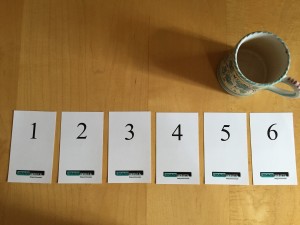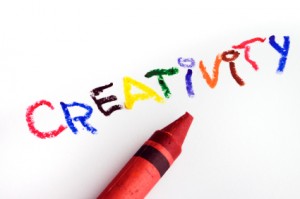Equal Opportunity Idea Generation

Pick a card.
At the beginning of each term, I give my critical thinking students a set of six cards. Each card has a number on it – one through six. (I also add my logo to do a little low-cost branding).
Students bring the cards to each class. I use them to guide discussions about topics where there is no obvious right answer. I ask a question with up to six alternative answers. I then ask the students to select the “best” answers and — when I give a signal – to hold up the number that represents their choice.
The trick is to do it simultaneously. Then I say something like, “Jamal, you’re holding up number six and Carmen is holding up number three. Let’s discuss why you’ve chosen different answers.” This often leads to some very robust discussions. Nobody hides and everyone knows that they may be asked to explain their opinion. If you mix in a little humor, it can also be a lot of fun.
I call these equal opportunity discussions. In most discussions, I find that whoever speaks first exerts undue influence on every subsequent speaker. It’s a phenomenon called social convergence and it’s impossible to eliminate unless you have everyone “speak” simultaneously. With simultaneous responses, everyone has an equal opportunity to get their idea across.
I first used this system during the merger of Lawson, an American software company, and Intentia, a Swedish software company. Both companies had about 2,000 employees. They also had different national traditions and corporate cultures. Every employee had an opinion about what the new company culture should be. The question for managers (including me) was: how do we gather, weigh, and merge these opinions?
We decided to use equal opportunity discussions focused on how the new culture would respond to different behaviors. For instance, in a meeting with up to a dozen employees, we might ask a simple question: “Klaus is always late to staff meetings. In our new company culture, what do you think Klaus’ manager should do?” We included a list of up to six answers. We asked the employees to consider the answers and then hold up her or his chosen answer simultaneously. This produced some very spirited discussions.
We kept track of how different groups answered each question. Did marketers answer the questions differently than, say, engineers? How about executives versus individual contributors? It took time but it was very valuable information that ultimately led to a coherent new culture.
A similar technique works well in promoting innovation. The first step is to gather a wide range of diverse ideas. Letting one person speak first (especially the boss) will reduce diversity. When I ran staff meetings focused on creating new ideas, I would frame up the issues several days in advance. I asked each participant to consider the issue and develop his or her best ideas. I then asked them to write down their ideas – no more than a paragraph or two. When we got to the meeting, I asked everyone to push their written descriptions to the middle of the table. I then gathered them up, shuffled them a bit, and started the discussion.
I thought about these processes when I spotted a recent article in Harvard Business Review titled, “People Offer Better Ideas When They Can’t See What Others Suggest.” The context is slightly different – the authors are looking at programs like Dell’s Idea Storm site or the My Starbucks Idea site.
Though the context is different, the process is essentially the same. The authors write that, “The trick is to avoid clustering, where the same people have the same experiences.” They also created anti-clustering software that ensures “…that no participants share the same body of ideas and the same neighbors as anyone else.”
I’m sure the anti-clustering software is more sophisticated than my cards. But if you want to get off to a quick start, the cards work pretty well. Just make sure that every idea has an equal opportunity to “win”.
How Long Does It Take (To Have A Good Idea)?

Developing a slow hunch.
Friends often ask me how long it takes to write one of my web articles. I can frame the question narrowly or broadly. In the narrow frame, the answer might be 90 minutes or so. In the broad frame, it might be 30 years or so. Talk about a slow hunch.
I’ll illustrate with my most recent article: Hate, Happiness, Imagination. As with many things – especially innovations – the article is a mashup of several different sources and concepts. Let’s track them in chronological order.
The first idea came to me through Graham Greene’s brilliant novel, The Power and the Glory. The novel includes a lovely quote: “Hate is the failure of imagination”. Greene wrote the novel in 1940, so the idea is now at least 75 years old (or perhaps older since Greene seems to echo previous authors).
I read the novel when Suellen and I lived in Guanajuato, Mexico in 1980. The quote about hate and imagination struck me and has stuck with me ever since. So, I’ve been gestating the idea for 35 years. I would occasionally mention it to friends but, otherwise, I didn’t do much with it.
In 2005, David Foster Wallace gave his famous commencement speech at Kenyon College. He stressed that, all too often, we fail to imagine what life is like for other people. If we did use our imagination more fully, we would empathize more, and our lives would be richer and fuller. First, we have to recognize that we can make a choice — that we don’t have to operate on our egocentric default setting. Second, we actually have to make the choice.
I didn’t know about Wallace’s speech until I started teaching critical thinking. As I looked for sources, I came across a video of the (abridged) speech and used it several times in my class. I first stumbled across it in 2012.
I didn’t do much with the Kenyon College speech until a few weeks ago. Frankly, I had forgotten about it. Then one of my students discovered it and asked me to show it to the class. That led to a very healthy discussion during which I connected what Wallace said to what Greene wrote.
Bingo! I made the connection between the two ideas. Why did it take me so long? Probably because I was just thinking about it. Thinking is fine but I don’t think that merely thinking creates many new ideas. The give-and-take of the class discussion stimulated me to make new connections. The diversity of opinions helped me open up new connections rather than merely deepening old connections.
Still, I didn’t have a complete thought. Then Suellen read me a paragraph from a review of the new biography of Saul Bellow. The review mentioned Bellow’s belief that imagination is “eternal naïveté”. When I realized what he meant by that, it dawned on me that it completed the thought. Greene connected to Wallace connected to Bellow.
What can we learn from this? First, this little story illustrates Steven Johnson’s idea of the “slow hunch”. Many good ideas – and most innovations – result from mashing up existing ideas. Unfortunately, we don’t get those ideas simultaneously. We may get one in 1980, another in 2012, and another last month. The trick is to remember the first one long enough to couple it with the second one. (Writing a blog helps).
The other point is that the pure act of thinking is (often) not enough. We need to kick ideas around with other people. Diversity counts. I’m lucky that I can kick ideas around with my students. And with Suellen. If not for them, I wouldn’t be nearly as interesting as I am.
So, how long does it take me to have a good idea? About 35 years.
How To Have A Good Idea – Part 1
We often think that good ideas are random events. We might say, for instance, that “the idea just popped into my head” or it “just occurred to me.” We may convince ourselves that we’re not the authors of our own ideas. They just happen.
But having a good idea is really no different than any other skill. The more we practice, the better we become. We can train ourselves to create more ideas. The more ideas we produce, the more chance we have of producing good ones. As Scott Adams, the creator of Dilbert, has remarked, “Creativity is allowing yourself to make mistakes. Art is knowing which ones to keep.”
So how do you create ideas and, especially, how do you create good ones? The first step is to pay attention. We all have good ideas from time to time. Pay attention to what you’re doing when you have a good idea. Then do more of that.
With that thought in mind, I’ve asked the students in several editions of my Critical Thinking class what they were doing the last time they had a good idea. Here’s a list, in no particular order.
Taking a walk – I haven’t kept precise count but this is certainly one of the most frequently mentioned activities. It’s also my favorite. Whenever I need a good idea, I go for a walk.
Out for a run – like walking, only faster.
Going for a drive – also fairly popular and may be related to highway hypnosis.
Taking a shower – another frequent one.
Reading – this one comes up fairly often, especially reading in bed before falling asleep. As I’ve noted before, sleepy people seem more creative.
Meditation – most of my students don’t meditate but the ones who do often mention it as a time when they get good ideas.
On the subway or bus, commuting – a routine action repeated most every business day; apparently the mind wanders.
On the elevator – this was a student from New York where I gather they take long elevator rides.
Lifting weights at the gym – I suspect that System 1 is lifting the weights while System 2 is rummaging around in more interesting topics.
Dreaming – this comes up occasionally. As one student put it, “I had a fabulous idea for work and had to wake up and write it down.”
Listening to others and listening to colleagues – nobody has told me that they have a good idea when talking. A number of students have told me the ideas come when they’re listening.
Mowing the lawn – it’s a good time to let your mind wander.
Over a cup of coffee in the quiet morning before the kids get up – what a delicious time.
Sitting on the couch talking and strategizing the next day’s plan with my wife – another lovely moment.
I’m struck by how many of the idea-generating activities involve motion. We’re walking or running or driving the car or riding the subway. We’re moving through space and there’s a lot to stimulate our System 1. Yet we don’t have to do much consciously; our System 2 is free to wander. We’re daydreaming but we don’t realize it.
Many of the activities find us alone – like driving or meditating – or alone in a crowd – like riding the subway. We seem to need some stimulus but we also need to withdraw into a quiet, inner space.
Not many students have mentioned having good ideas while in a meeting. But when they do, they often mention the alone-in-a-crowd experience. They may not know many people in the meeting or they’ve mentally checked out for a while. There’s some stimulus but the mind is wandering.
It occurs to me that most of these activities are a form of meditation. We don’t think of it as such but we’re occupying System 1 with routine activities – not unlike chanting a mantra – and allowing System 2 to wander. We don’t think of ourselves as a nation of meditators but perhaps we are.
So, how about it? What were you doing the last time you had a good idea?
Creativity Templates – 2

Pictorial Analogy
A few days ago, I wrote about the study that Jacob Goldenberg et. al. used to demonstrate the effectiveness of creativity templates. Goldenberg and his associates used several different methods to create and test ads. They found that six creativity templates – though not foolproof – consistently created better ads than alternative methods.
So what were the templates? Here they are. (Note: Some of the examples used come from the original article, others come from my experiences).
Template 1 – Pictorial Analogy – uses a picture to exemplify the product (or product attribute) in a compelling way. Two basic versions exist:
Version 1 – Replacement – in illustrating the complexity of warehouse management, we used a picture of a gumball machine filled with different colored gumballs. The picture “replaces” the warehouse and emphasizes the difficulty of getting the right inventory off the shelf and delivered to customers.
Version 2 – Extreme analogy – the picture represents something extreme about the product. For instance, running shoes that cushion the shock might be illustrated with landing gear on a space ship touching down on Mars.
Template 2 – Extreme Situation – creates an unrealistic situation to emphasize key attributes.
Version 1 – Absurd alternative – a security alarm ad shows a woman barking at intruders to scare them away. You don’t have to use our alarm system. You can always learn to bark like a dog – an absurd alternative.
Version 2 – Extreme attribute – exaggerate a product attribute to the absurd. To communicate that a Jeep can go anywhere, show it driving along the bottom of the ocean
Version 3 – Extreme worth – exaggerate the worth of a product feature to the absurd.
Template 3 – Consequences – illustrates the (exaggerated or extreme) consequences of using or not using the product.
Version 1 – Extreme consequences – at a B2B software company, we sent hammocks to a select group of CIOs to give them a place to relax after they bought our software.
Version 2 – Inverted consequences – we also sent straitjackets (real ones – very creepy) to another group of CIOs to show them how they would feel if they didn’t buy our software. Note: the straitjackets worked better.
Template 4 – Competition – the product (or attribute) is shown competing with a product from a completely different class
Version 1 – Attribute in competition – to illustrate the speed of a car, show it racing a bullet.
Version 2 – Worth in competition – not how it performs (speed) but how much it’s worth to you
Version 3 – Uncommon use – a young couple’s car breaks down. A friend offers to tow them but doesn’t have a towrope. They use the husband’s jeans as a towrope. An uncommon use that illustrates the product’s toughness.
Template 5 – Interactive Experiment – invites the viewer into an experiment which demonstrates the need for the product or service
Version 1 – Activation version – you actually engage in the experiment. For instance, you’re invited to scratch your head over a black patch in a magazine. If white flakes appear on the black patch, you need our dandruff shampoo
Version 2 – Imaginary experiment – well, imagine this …
Template 6 – Dimensionality Alteration — change the relationship between the product attribute and the environment.
Version 1 – New parameter – change an attribute in the environment to accentuate the product attribute. To accentuate the color of a shirt, create a photo in which everything is in black-and-white except the shirt.
Version 2 – Multiplication – multiply the product (or product attribute) and then compare it to something in the environment. Example: early Hyundai ads, where two Hyundais cost less than one entry-level Toyota.
Version 3 – Division – divide the product into component parts and compare them to each other and/or to the environment.
Version 4 – Time leap – present an ordinary scenario but make it interesting by shifting it to the past or future. A wife argues with her husband about why he cancelled the life insurance. Sounds ordinary, until you realize that it’s set in the future, when the husband is already dead.
Do these templates always work? Well…. no. But I can attest that they are more efficient and effective than classic brainstorming techniques where no answer is wrong and we throw everything on the white board to see what sticks. Go ahead, give ’em a try.
Creativity Templates – 1
 I’m pretty good at leading brainstorming sessions. I can get people involved, gin up the excitement, and lead a rollicking session. They’re a lot of fun. But are they productive?
I’m pretty good at leading brainstorming sessions. I can get people involved, gin up the excitement, and lead a rollicking session. They’re a lot of fun. But are they productive?
Traditional brainstorming techniques derive from the concepts of free association and divergent thinking which, as Wikipedia notes, “… is a thought process used to generate creative ideas by exploring many possible solutions.” By exploring many different options, we may come up with something useful.
At the very least, it sounds inefficient – like the random programming of computers. Indeed, I rarely find useful ideas in traditional brainstorming sessions. A session may generate a lot of ideas but many of them of them are either trite or just plain silly.
So I was pleased to find a set of “creativity templates” in an article published in 1999 by Jacob Goldenburg, David Mazursky, and Sorin Solomon of the Jerusalem Scool of Business Administration.
The article investigates high quality advertisements. Do they have common features (templates) and can we use those commonalities to create better ads? The authors studied 200 award-winning ads and identified six basic templates (and several sub-templates). The researchers then compared the award-winning ads (let’s call it Group 1) to two other groups:
- Group 2 — 200 ads that had been selected for The One Show Album, a book of well-respected ads. Though selected for the album, these ads had not won other awards.
- Group 3 – 200 ads selected from the same publications and the same product categories as Groups 1 and 2, but that had not been selected for a collection and had not won awards.
Independent judges could classify 89% of the Group 1 ads into one of the six templates. Of the Group 2 ads, 50% used one of the templates. In Group 3, only 2.5% of the ads used one of the templates. So, the templates correlate to higher quality ads.
The researchers then tested whether their insights could be used to create new ads. They established three separate “creative teams” and asked each to create ads for fictional products. The teams were:
- Team 1 – “… was requested to generate ads based only on a brief (without additional training)…”
- Team 2 – received the same briefs as Team 1 but was also taught classic brainstorming techniques, including free association, before generating ads.
- Team 3 – also received the same briefs but was trained to use the creativity templates before generating ads.
Twenty participants were randomly assigned to the three teams and received the designated training. Each group then generated ads for several product categories.
The ads thus produced were then randomized and evaluated in a number of ways. The researchers recruited judges who did not know the objectives of the study and who used well-established criteria for advertising quality.
The findings were quite straightforward. “First, ‘template training’ was found to be superior to ‘no training’ and ‘free association” training and in all the comparisons pertaining to … ad quality measures. … In all cases, template training was superior to training in free association.”
Additionally, the research cast doubt on the efficacy of the free association method used by Team 2. “No clear indication was found that the free association method heightens creativity or brand attitude.” In other words, my frustration with brainstorming may well be justified – it doesn’t increase creativity.
So what are the six templates? We’ll get to that tomorrow. Stay tuned.
